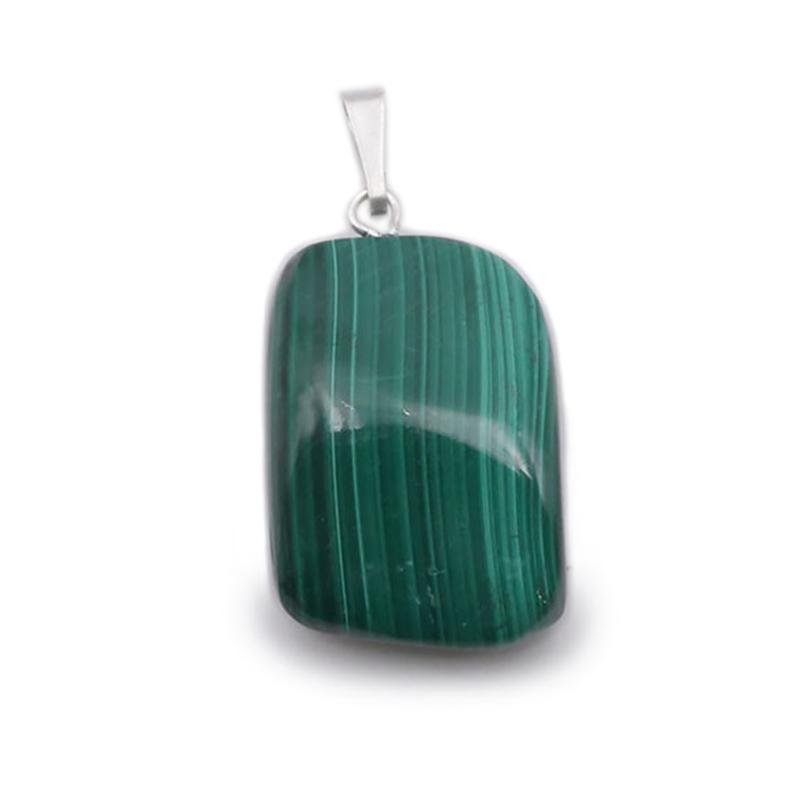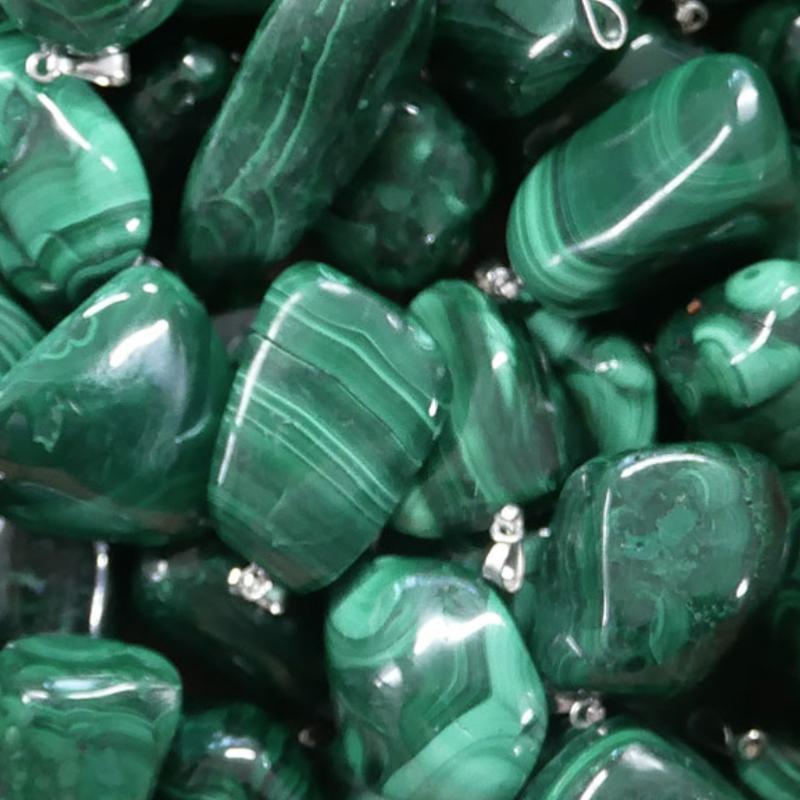1
/
of
2
Congo AA malachite pendant (rolled stone)
PEN-MALPR-01
8c984efa-30a8-5524-41cc-ae7b332135e6
028d80eb-2b30-41d4-b221-bda49eca04cf
- Regular price
-
12,90 € - Regular price
-
12,90 € - Sale price
-
12,90 €
Tax included.
Shipping calculated at checkout.
Couldn't load pickup availability
Learn more
PEN-MALPR-01
Origin: Congo
Grade: AA
Discover the properties of our malachite pendant (rolled stone)
Dimensions:
About 30-40mm
Weight:
Between 12g
Origin:
Congo
Grade:
AA = very high
Malachite tumbled stone of approximately 30-40mm pierced by a steel bail.
Shapes, patterns and colors may vary from one stone to another
The name malachite comes from the ancient Greek “malaikhé” which translates as “mauve”. This is not the name of the color mauve, but of the plant called "mauve", (a plant which has magnificent, relatively soft green leaves).
Another hypothesis indicates that the origin of the name malachite comes from the Greek “Malachos” which means “soft” in reference to the tenderness of the stone. It is often this interpretation that is retained.
Malachite belongs to the large family of carbonates. This stone is in fact a true hydrated copper carbonate. It has a hardness of 3.5 to 4 on the Mohs scale, which makes it a soft stone. Working with it in jewelry requires skill to avoid breaking or scratching it.
This stone is easily recognized thanks to its green, more or less dark, more or less light, dotted with light veins, or on the contrary black. Its green color results from the presence of copper. More rarely, malachite sometimes takes the form of prismatic crystals.
Unlike many stones, malachite has many stories, legends and myths to its credit. The first uses of malachite date back to at least 4,000 BC. We can say that its history dates back to the dawn of time. For millennia, malachite has been used by many civilizations for therapeutic, medicinal, cosmetic and decorative purposes.
In ancient Egyptian times, the venerable green stone was the symbol of rebirth, eternal youth and good health. For the Egyptians, death is the sign of new life. They even name the afterlife as the realm of malachite.
Egyptian women wore malachite as an amulet bearing the image of Thouéris, protective goddess of motherhood. On a daily basis, malachite is crushed and used as cosmetics (eye shadow), while being known to relieve eye infections.
The ancient Greeks considered malachite a protective stone with many medicinal properties. Fighters wore it as an amulet in war. The Greeks also discovered the delicate and careful engraving of malachite cameos. Then, malachite was widely used in the creation of ornamentation on facades, living rooms and corridors. The temple of Artemis in Ephesus, one of the seven wonders of the world, is decorated with malachite.
In Roman civilization, malachite was often confused with chrysocolla. However, Pliny the Elder (23 AD - 79 AD), famous naturalist, described it perfectly in his encyclopedia Natural Histories. The Romans offered malachite in the form of pendants to children to protect them from lightning in the event of a storm.
In the Middle Ages, curious faculties were attributed to malachite, notably that of understanding animals! However, Jean de Mandeville (beginning of the century - 1372), famous explorer, described malachite and attributed the same virtues to it: protection of children against bad luck, against enemies' wounds and against certain diseases.
At this time, malachite, imported from the Middle East, was reduced to powder, then used to tint icons, wall frescoes and illuminations green.
Nowadays, many creations in malachite are visible throughout the world. In the United States, in 1819, the French sculptor Pierre-Philippe Thomire created the bronze ornamentation of the Demidof Vase in malachite veneer, 1.71 m high.
In France, there is even the malachite salon at the Château du Grand Trianon in Versailles. Most ornamental malachite objects, visible in museums and castles, come from Russian malachite deposits, notably those from the Ural mines.
The main deposits are located in Congo, Australia, Canada, Germany, Mexico, etc.
In Lithotherapy, malachite, with its green color, restores energy and vitality. In spring, nature reveals greens of all shades, from light green to dark green. Spring symbolizes renewal. This green color of malachite brings hope and serenity. It helps combat stress and anxiety.
Wearing malachite gives vitality and energy. It makes you want to have projects and carry them out. It allows you to overcome the difficulties of life. This stone is a real moral support.
It encourages change and improves connections with others. It allows you to open up to others, to strengthen compassion and empathy. The person demonstrates listening and understanding. The dialogues and relationships are of quality.
Malachite improves the power of persuasion by providing clear, concise and structured speech. It also helps develop self-confidence and self-esteem. This stone radiates powerful positive waves.
Placed in a bedroom, it helps chase away dark thoughts and generates restorative and soothing sleep. It fights effectively against states of intense sadness.
Origin: Congo
Grade: AA
Discover the properties of our malachite pendant (rolled stone)
Dimensions:About 30-40mm
Weight:
Between 12g
Origin:
Congo
Grade:
AA = very high
Shapes, patterns and colors may vary from one stone to another
Another hypothesis indicates that the origin of the name malachite comes from the Greek “Malachos” which means “soft” in reference to the tenderness of the stone. It is often this interpretation that is retained.
Malachite belongs to the large family of carbonates. This stone is in fact a true hydrated copper carbonate. It has a hardness of 3.5 to 4 on the Mohs scale, which makes it a soft stone. Working with it in jewelry requires skill to avoid breaking or scratching it.
This stone is easily recognized thanks to its green, more or less dark, more or less light, dotted with light veins, or on the contrary black. Its green color results from the presence of copper. More rarely, malachite sometimes takes the form of prismatic crystals.
Unlike many stones, malachite has many stories, legends and myths to its credit. The first uses of malachite date back to at least 4,000 BC. We can say that its history dates back to the dawn of time. For millennia, malachite has been used by many civilizations for therapeutic, medicinal, cosmetic and decorative purposes.
In ancient Egyptian times, the venerable green stone was the symbol of rebirth, eternal youth and good health. For the Egyptians, death is the sign of new life. They even name the afterlife as the realm of malachite.
Egyptian women wore malachite as an amulet bearing the image of Thouéris, protective goddess of motherhood. On a daily basis, malachite is crushed and used as cosmetics (eye shadow), while being known to relieve eye infections.
The ancient Greeks considered malachite a protective stone with many medicinal properties. Fighters wore it as an amulet in war. The Greeks also discovered the delicate and careful engraving of malachite cameos. Then, malachite was widely used in the creation of ornamentation on facades, living rooms and corridors. The temple of Artemis in Ephesus, one of the seven wonders of the world, is decorated with malachite.
In Roman civilization, malachite was often confused with chrysocolla. However, Pliny the Elder (23 AD - 79 AD), famous naturalist, described it perfectly in his encyclopedia Natural Histories. The Romans offered malachite in the form of pendants to children to protect them from lightning in the event of a storm.
In the Middle Ages, curious faculties were attributed to malachite, notably that of understanding animals! However, Jean de Mandeville (beginning of the century - 1372), famous explorer, described malachite and attributed the same virtues to it: protection of children against bad luck, against enemies' wounds and against certain diseases.
At this time, malachite, imported from the Middle East, was reduced to powder, then used to tint icons, wall frescoes and illuminations green.
Nowadays, many creations in malachite are visible throughout the world. In the United States, in 1819, the French sculptor Pierre-Philippe Thomire created the bronze ornamentation of the Demidof Vase in malachite veneer, 1.71 m high.
In France, there is even the malachite salon at the Château du Grand Trianon in Versailles. Most ornamental malachite objects, visible in museums and castles, come from Russian malachite deposits, notably those from the Ural mines.
The main deposits are located in Congo, Australia, Canada, Germany, Mexico, etc.
In Lithotherapy, malachite, with its green color, restores energy and vitality. In spring, nature reveals greens of all shades, from light green to dark green. Spring symbolizes renewal. This green color of malachite brings hope and serenity. It helps combat stress and anxiety.
Wearing malachite gives vitality and energy. It makes you want to have projects and carry them out. It allows you to overcome the difficulties of life. This stone is a real moral support.
It encourages change and improves connections with others. It allows you to open up to others, to strengthen compassion and empathy. The person demonstrates listening and understanding. The dialogues and relationships are of quality.
Malachite improves the power of persuasion by providing clear, concise and structured speech. It also helps develop self-confidence and self-esteem. This stone radiates powerful positive waves.
Placed in a bedroom, it helps chase away dark thoughts and generates restorative and soothing sleep. It fights effectively against states of intense sadness.



Congo AA malachite pendant (rolled stone)
- Regular price
-
12,90 € - Regular price
-
12,90 € - Sale price
-
12,90 €
8c984efa-30a8-5524-41cc-ae7b332135e6
028d80eb-2b30-41d4-b221-bda49eca04cf
-
100% SECURE PAYMENT
Paypal, credit card, check, transfer
-
FREE DELIVERY
from 40€ purchase
-
SATISFIED OR REFUNDED
14 days to change your mind
-
CUSTOMER SERVICE AVAILABLE
contact@laboiteacailloux.com
Subscribe to our newsletter
to receive all our offers, good deals and new products from La Boite à Cailloux



